At the outbreak of war, the SMS Konigsberg a cruiser in Admiral von Spey’s squadron in the Pacific, was a principal concern of Admiral King-Hall on the Royal Navy’s South Africa station.
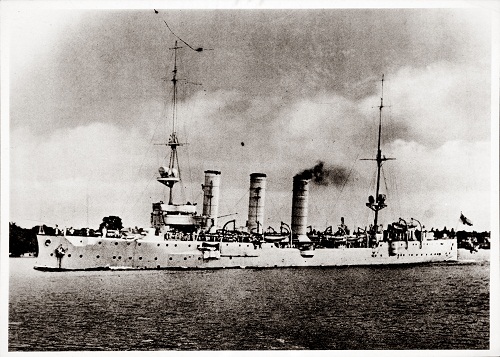
SMS Konigsberg taken at Dar-es-Salaam 1914 CO1069/153 pt3 (23)
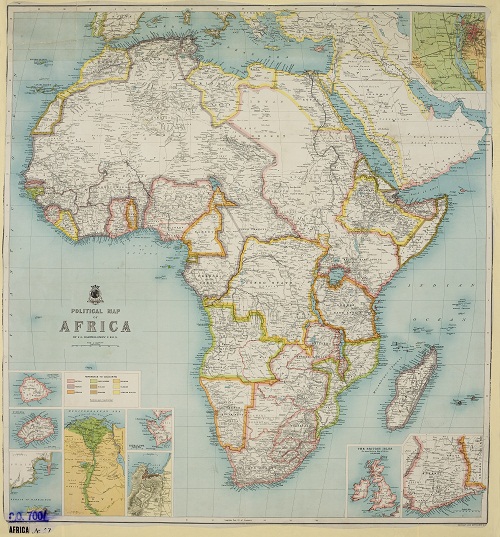
Political Map of Africa CO 700/Africa27
The Konigsberg left Dar-es-Salaam, German East Africa on 31 July 1914, tracked by a combination of three British warships: Astraea, Hyacinth and Pegasus. Admiralty correspondence shows that on 1 August 1914 the Konigsberg slipped her escort as ‘it was not possible to shadow her for any time as Hyacinth had very little coal, and with the fuel (patent) in use, could not get more than 16 Knots at full speed’ (ADM 137/8). The availability of coal and its quality would affect both the Konigsberg and the British ships, limiting the effectiveness of their operations.
Within days she was off Aden and was threateningly placed in the shipping lane of freighters heading for the Suez Canal. Raiding the key shipping route from India to Britain via the Suez Canal was seen as a way to disrupt the British war effort and destroy key supplies. Max Looff, the Konigsberg’s captain would need to replenish fuel supplies by raiding merchant ships. A problem he faced was that the merchant ships were mainly carrying inferior coal which often could not be used. An example of was Looff’s capture of the City of Winchester near Aden on 6 August 1914, which was carrying inferior Bombay coal (ADM 137/9).
No contact was made with the Konigsberg until 20 September 1914, when the Admiralty received a telegram from Zanzibar at 7.30 am: Konigsberg reported not damaged, Pegasus sunk. The Pegasus had been in Zanzibar harbour to repair engines and for cleaning down, when the Konigsberg carried out the surprise attack. The Pegasus returned fire but fell short and was severely damaged within several minutes. The correspondence shows that the Admiralty then realised that the Cape squadron needed be strengthened by two or three swift light cruisers of the Konigsberg type, so that they could protect convoys and locate and destroy the German cruiser (ADM 137/9).

ADM 137/9 Telegram from Admiralty ordering better suited ships to the area
The documents show that from October 1914 that the Konigsberg was sheltering deep within the Rufigi River delta, over 100 miles south of Dar-es-Salaam. The Rufigi River splits in to many branches, before entering the sea, forming a vast delta of some 100 square miles. The channels are in nearly every case unnavigable for any but the lightest draft boats. It was a position which rendered attack most difficult, as only shallow draught ships could approach close enough to attack (ADM 1/8402/416).
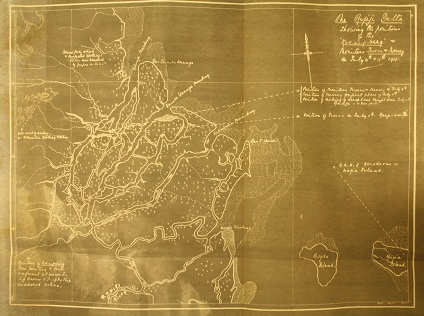
Map of Rufigi Delta CAB 45/218 show positions of Monitors, RNAS and Konigsberg
After the sinking of the Pegasus, the Konigsberg had been pursued by HMS Chatham to the Rufigi River; on 22 November 1914 the recently commissioned Flight Sub-Lieutenant Cutler of the Royal Navy Air Service (RNAS) used his hydroplane to carry out the first aerial reconnaissance. The Konigsberg was located at least seven or eight miles within the delta. Engine failure forced Cutler to land near the Konigsberg and was taken prisoner.
In December 1914, it was evident that operations against the Konigsberg were stalled. The RNAS was asked to carry out a further mission. In spite of various technical difficulties, the first reconnaissance fights took place on 25 April 1915, when the Konigsberg’s position was photographed. In May HMS Chatham was withdrawn and replaced by, two monitors, HMS Severn and Mersey, which were designed to operate in shallow waters, arriving in the area 3 June, shortly followed by aircraft based on the recently captured Mafia Island (AIR 1/674/21/6/86).
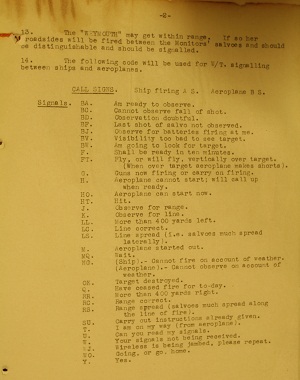
AIR 1/674 Appendix A Orders for aeroplanes and guns for the attack 6 July 1915
The attack was fixed for 6 July 1915 as the most appropriate date in terms of tides and monsoon season. The attack began as an aircraft carrying bombs took off from Mafia Island shortly after 5am This was to divert attention as the monitors entered the northern channel of the Rufigi (CAB 45/218).
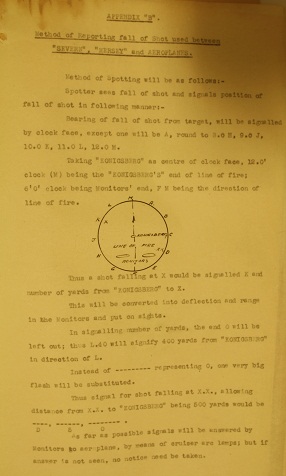
Appendix B method of reporting fall of shot between “Severn”, “Mersey” and the aeroplanes AIR 1/674.
The two monitors took up their prearranged positions, just east of the island of Gengeni, while the RNAS began to drop bombs from a height of 6,000 feet that exploded close to the ship (AIR 1/674/21/6/86). At about 7:30am, the Mersey was hit twice and was forced to move out of range. At about 7:55am the Severn’s guns hit their target, apparently knocking out the Konigsberg’s forward gun. Both of the British ships continued to fire during the day, but nothing further was achieved and it became apparent that a second operation would be necessary (CAB 45/218, AIR 1/674/21/6/86).
On Sunday 11 July the second attempt to destroy the Konigsberg began at 11am. The Severn took up an attacking position, while the Mersey drew the Konigsberg’s fire. The Konigsberg continued to fire salvoes from four guns until 12:42, but within a further 20 minutes the guns had been disabled (AIR 1/674/21/6/86). The British ships continued their barrage until 2.20pm, by when it was obvious that no further action was necessary (CAB 45/218). Captain Looff noted that the ship was scuttled around sundown and that ‘SMS Koenigsberg is destroyed, but is not conquered’ (ADM 137/4297).
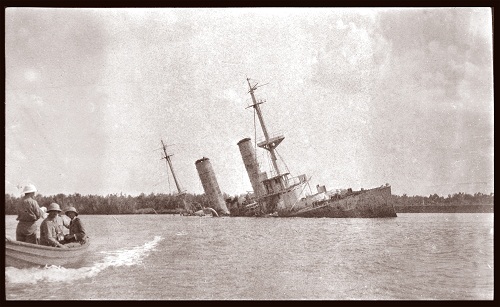
ADM 137/3853 The wreck at half tide, looking west.
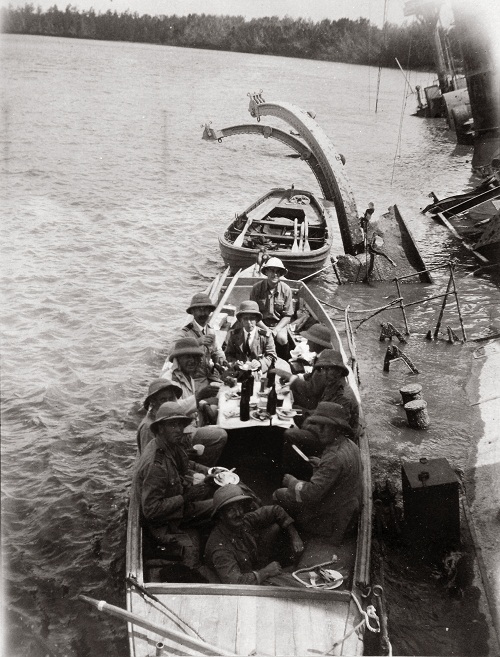
ADM 137/3853 View along Starboard side – British visiting the Konigsberg to see if she could be salvaged.
The destruction of the German light cruiser Konigsberg in the Rufigi delta during July 1915, although only a minor naval operation, was unique in character. It is an early example of cooperation between aircraft and warship in attacking a target which could not be directly sited (AIR 1/674/21/6/86). The incident was also significant, as it left the Royal Navy in effective control of the Indian Ocean.

What happened to Fl.Sub.Lt. Cutler?
This is not family history but I would be interested to know what happened to Sub.Lt. Cutlet mentioned in the report.
Hello David
Thank you for your comments
Fl.Sub.Lt. Cutler remained a POW for the duration of the war.
Just to follow up..
Herbert Dennis Cutler has four service records
ADM 273/4/52
ADM 273/28/5
ADM 273/29/223
AIR 76/120/48
The records record the date of birth as 10/7/1887, that he was commissioned 7/5/15. He was released and returned to the UK 30/1/18 and went on to become an instructor with the RAF and was discharged 19/2/19. Herbert was flying in Durban when asked to join the search for the Konigsberg as tracking her position from sea alone was not possible. There are details of Cutlers efforts in CAB 45/218
Some relics of SMS Konigsberg are, or were until recently, in the Railway Museum in Nairobi. At least some of her guns were salvaged and used by German forces in East Africa.
Hello Graham
Thank you for your comments – It is good to know that some of the Relics and Artefacts are still accessible. From what I have read it appears that all ten 105mm guns were salvaged, converted and used during the conflict in German East Africa, as well as some of the crew and the wireless.
Edward Paice’s history of the East Africa campaign says that only fifteen of the Konigsberg’s crew ever got back to Germany. This theatre of war is mostly forgotten but is fascinating.
It is certainly fascinating and there will be more blogs looking at aspects of the African theatre – which may be of interest. I am not sure I have read that particular offering from Edward Paice, will certainly take a look! One book that I have found useful and interesting is Hew Strachan’s The First World War in Africa.
I have heard, but am not certain of the truth of the claim, that GG Campbell, who was later Vice Chancellor of the University of Natal, was one of the pilots involved in the destruction of the Konigsberg.
Was radio communication involved?
Hello Clive
Yes, radio communication was involved to spot and signal the fall of shot. The Weymouth, Mersey and Severn were tuned to “D” wave-length which was being used by the aeroplanes (AIR 1/674). I have not confirmed if GG Campbell was one of the pilots, he is not listed in the records I have looked at. There is one G.G Campbell to be found in the officers’ service records (AIR 76/74/111), but there is nothing recorded to confirm if he is the correct person or that he was active in July 1915.
It is interesting to learn about German ship’s activities in Indian ocean other than which is mostly known (SMS EMDEN). KONIGSBERG chapter is mostly forsaken due to overwhelming operations of EMDEN.
But, indeed KONIGSBERG also played vital role in creating distraction among allied ships in the region.
The two RNAS aircraft used against the Konigsberg were 2-seater Sopwith 807 floatplanes.
Wilbur Smith’
Shout At The Devil.
May not be accurate regarding the Great War and East Africa: but is a great read!
Railway Museum Nairobi also interesting.